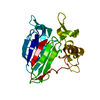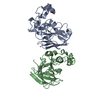+ Open data
Open data
- Basic information
Basic information
| Entry | Database: PDB / ID: 7p23 | ||||||
|---|---|---|---|---|---|---|---|
| Title | Thaumatin-like protein of Puccinia graminis | ||||||
 Components Components | Thaumatin-like protein of Puccinia graminis | ||||||
 Keywords Keywords | UNKNOWN FUNCTION / Thaumatin-like protein | ||||||
| Function / homology | Thaumatin family / Thaumatin family / Thaumatin family profile. / Thaumatin family / Osmotin/thaumatin-like superfamily / defense response / Thaumatin-like protein 1 Function and homology information Function and homology information | ||||||
| Biological species |  Puccinia graminis f. sp. tritici (fungus) Puccinia graminis f. sp. tritici (fungus) | ||||||
| Method |  X-RAY DIFFRACTION / X-RAY DIFFRACTION /  SYNCHROTRON / SYNCHROTRON /  MOLECULAR REPLACEMENT / Resolution: 1.5 Å MOLECULAR REPLACEMENT / Resolution: 1.5 Å | ||||||
 Authors Authors | Eder, M. / Hofer, G. / Odabas, M. / Keller, W. | ||||||
| Funding support |  Austria, 1items Austria, 1items
| ||||||
 Citation Citation |  Journal: To Be Published Journal: To Be PublishedTitle: The structure of Thaumatin-like proteins of a bacterial, a fungal and an animal origin Authors: Eder, M. / Hofer, G. / Odabas, M. / Keller, W. | ||||||
| History |
|
- Structure visualization
Structure visualization
| Structure viewer | Molecule:  Molmil Molmil Jmol/JSmol Jmol/JSmol |
|---|
- Downloads & links
Downloads & links
- Download
Download
| PDBx/mmCIF format |  7p23.cif.gz 7p23.cif.gz | 221.7 KB | Display |  PDBx/mmCIF format PDBx/mmCIF format |
|---|---|---|---|---|
| PDB format |  pdb7p23.ent.gz pdb7p23.ent.gz | 177.8 KB | Display |  PDB format PDB format |
| PDBx/mmJSON format |  7p23.json.gz 7p23.json.gz | Tree view |  PDBx/mmJSON format PDBx/mmJSON format | |
| Others |  Other downloads Other downloads |
-Validation report
| Summary document |  7p23_validation.pdf.gz 7p23_validation.pdf.gz | 420.8 KB | Display |  wwPDB validaton report wwPDB validaton report |
|---|---|---|---|---|
| Full document |  7p23_full_validation.pdf.gz 7p23_full_validation.pdf.gz | 420.9 KB | Display | |
| Data in XML |  7p23_validation.xml.gz 7p23_validation.xml.gz | 24.2 KB | Display | |
| Data in CIF |  7p23_validation.cif.gz 7p23_validation.cif.gz | 37.4 KB | Display | |
| Arichive directory |  https://data.pdbj.org/pub/pdb/validation_reports/p2/7p23 https://data.pdbj.org/pub/pdb/validation_reports/p2/7p23 ftp://data.pdbj.org/pub/pdb/validation_reports/p2/7p23 ftp://data.pdbj.org/pub/pdb/validation_reports/p2/7p23 | HTTPS FTP |
-Related structure data
| Related structure data |  7p22C  2ahnS S: Starting model for refinement C: citing same article ( |
|---|---|
| Similar structure data | Similarity search - Function & homology  F&H Search F&H Search |
- Links
Links
- Assembly
Assembly
| Deposited unit | 
| ||||||||
|---|---|---|---|---|---|---|---|---|---|
| 1 | 
| ||||||||
| 2 | 
| ||||||||
| Unit cell |
|
- Components
Components
| #1: Protein | Mass: 26004.887 Da / Num. of mol.: 2 Source method: isolated from a genetically manipulated source Source: (gene. exp.)  Puccinia graminis f. sp. tritici (strain CRL 75-36-700-3 / race SCCL) (fungus) Puccinia graminis f. sp. tritici (strain CRL 75-36-700-3 / race SCCL) (fungus)Strain: CRL 75-36-700-3 / race SCCL / Gene: PGTG_18309 / Plasmid: pPpT4-alpha / Production host:  Komagataella pastoris (fungus) / Strain (production host): CBS7435 / References: UniProt: E3L7F9 Komagataella pastoris (fungus) / Strain (production host): CBS7435 / References: UniProt: E3L7F9#2: Chemical | ChemComp-NA / | #3: Water | ChemComp-HOH / | Has ligand of interest | N | Has protein modification | Y | |
|---|
-Experimental details
-Experiment
| Experiment | Method:  X-RAY DIFFRACTION / Number of used crystals: 1 X-RAY DIFFRACTION / Number of used crystals: 1 |
|---|
- Sample preparation
Sample preparation
| Crystal | Density Matthews: 2.37 Å3/Da / Density % sol: 48.03 % |
|---|---|
| Crystal grow | Temperature: 293 K / Method: microbatch / pH: 4.5 Details: PACT premier F12 (0.2 M Sodium nitrate, 0.1 M Bis-Tris propane pH 6.5, and 20 % w/v PEG 3350) |
-Data collection
| Diffraction | Mean temperature: 100 K / Serial crystal experiment: N |
|---|---|
| Diffraction source | Source:  SYNCHROTRON / Site: SYNCHROTRON / Site:  PETRA III, DESY PETRA III, DESY  / Beamline: P11 / Wavelength: 1.0332 Å / Beamline: P11 / Wavelength: 1.0332 Å |
| Detector | Type: DECTRIS PILATUS 6M / Detector: PIXEL / Date: Apr 23, 2017 |
| Radiation | Protocol: SINGLE WAVELENGTH / Monochromatic (M) / Laue (L): M / Scattering type: x-ray |
| Radiation wavelength | Wavelength: 1.0332 Å / Relative weight: 1 |
| Reflection | Resolution: 1.5→42.2 Å / Num. obs: 79992 / % possible obs: 99.96 % / Redundancy: 12.9 % / CC1/2: 0.995 / Rmerge(I) obs: 0.1396 / Rpim(I) all: 0.04067 / Rrim(I) all: 0.1456 / Net I/σ(I): 10.34 |
| Reflection shell | Resolution: 1.5→1.554 Å / Redundancy: 13.1 % / Rmerge(I) obs: 1.298 / Mean I/σ(I) obs: 1.41 / Num. unique obs: 7882 / CC1/2: 0.703 / Rpim(I) all: 0.3669 / % possible all: 99.84 |
- Processing
Processing
| Software |
| |||||||||||||||||||||||||||||||||||||||||||||||||||||||||||||||
|---|---|---|---|---|---|---|---|---|---|---|---|---|---|---|---|---|---|---|---|---|---|---|---|---|---|---|---|---|---|---|---|---|---|---|---|---|---|---|---|---|---|---|---|---|---|---|---|---|---|---|---|---|---|---|---|---|---|---|---|---|---|---|---|---|
| Refinement | Method to determine structure:  MOLECULAR REPLACEMENT MOLECULAR REPLACEMENTStarting model: 2ahn Resolution: 1.5→42.2 Å / SU ML: 0.16 / Cross valid method: THROUGHOUT / σ(F): 1.34 / Phase error: 18.98 / Stereochemistry target values: ML
| |||||||||||||||||||||||||||||||||||||||||||||||||||||||||||||||
| Solvent computation | Shrinkage radii: 0.9 Å / VDW probe radii: 1.11 Å / Solvent model: FLAT BULK SOLVENT MODEL | |||||||||||||||||||||||||||||||||||||||||||||||||||||||||||||||
| Displacement parameters | Biso max: 76.13 Å2 / Biso mean: 26.2133 Å2 / Biso min: 12.19 Å2 | |||||||||||||||||||||||||||||||||||||||||||||||||||||||||||||||
| Refinement step | Cycle: final / Resolution: 1.5→42.2 Å
| |||||||||||||||||||||||||||||||||||||||||||||||||||||||||||||||
| LS refinement shell | Refine-ID: X-RAY DIFFRACTION / Rfactor Rfree error: 0 / Total num. of bins used: 8
|
 Movie
Movie Controller
Controller



 PDBj
PDBj



